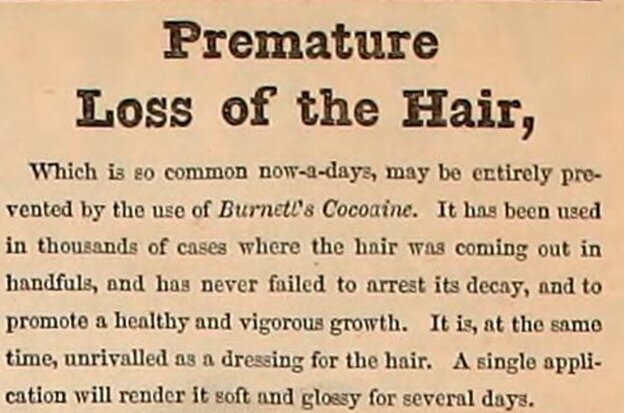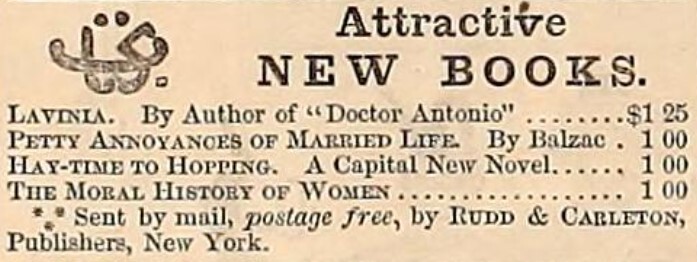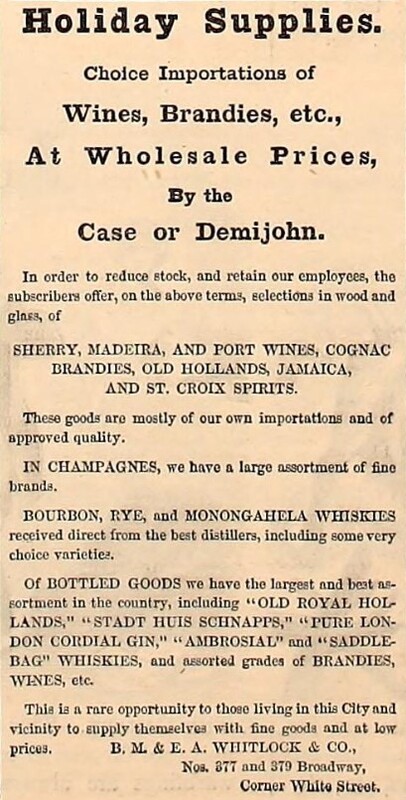Part 5
An Eldritch Horror Of The 1860s: How Dickens' Villainsiation Of Miss Havisham In Great Expectations Is Exacerbated By Social Conditions Of The Time
Charles Dickens’ Miss Havisham is by no means an ordinary character. Dickens created a character that is highly memorable, from the hem of her yellowed dress to the shroud she wears over her face in memory of the moment of her heartbreak. However, within the context of the time, Miss Havisham’s habits and eccentricites serve to make her destable and disgusting to the average reader. Within Dickens’ Great Expectations, Miss Havisham’s introduction to Pip is meant to bother the reader, Americans reading the story seeing her as a reflection of their own shortcomings and problems which exacerbates the percieved villany of Miss Havisham. She becomes the image of badness, become worse with the present cultural context.

Prevention of Hairloss
Hair loss seemed to be a concern for Americans in the 1860s, seeing as this is one of two advertisements on the page for hair loss prevention. Due to this advertisement centering ideals of “a healthy and vigorous growth” (Harper’s 815), it creates the idea that one can attain luxurious locks should they use this product. The head of hair can be used as a status symbol, representing health as per the words in the advertisement and contrasts the description of Miss Havisham, aged in her dress and stuck in a time of before. Her “room [is] stopped, like the watch and the clock, a long time ago” (Dickens 97), caught in a liminal space that she has carefully controlled to prevent moving out of that moment. Time moves on around her, but here, she does not have to confront its passage. The refusal of time comes again when Miss Havisham tells Pip she “know[s] nothing of the days of the week[…]nothing of weeks of the year” (Dickens 97), another direct rejection of the passage of time. Burnett’s Cocaine offers people a semblance of control over what would typically be considered uncontrollable, Miss Havisham attempting to control time in her home.
For those who purchase this product, there is an innate desire to remain with or chase their youth. For Miss Havisham, she desires to remain within the moment of her heartbreak forever. For those seeking out these hair treatments they seek youth or to project youthfulness, this being a shortcoming they wish to avoid. This product aims to “arrest [hair’s] decay”, suggesting that there is the notion a decay should one’s hair not be “soft and glossy” (Harper’s 815). This decay is also reminiscent of the mildewing that is seen on Miss Havisham’s clothing, creating this image of an elderly and bittered woman further being aged in the clothes she is wearing. To an outsider, “Miss Havisham is socially expected to neither look well nor age gracefully” (Baldellou 82). She does not have to look beautiful for she is old, therefore ugliness is reserved for age. Those who wish to remain young must therefore remain beautiful should they wish to avoid the judgement that will come with age. This is further reinforced with the knowledge that the “use of Estella’s youthful beauty [is] to pursue [Miss Havisham’s] plans of revenge” (Baldellou 82), reminding readers that Miss Havisham’s use of Estella is because she is young and pretty. This dependence of Estella’s body is a reconciliation between the knowledge of her old age and the need for youth and beauty to wreck havoc on the male sex as she wishes to. She cannot use her own body because of her age, reminding the reader that they too will soon reach a point in their life where they beauty will fade because of age. Burnett’s Cocaine promises customers they can also stop the clock, gaining back a part of what they have lost in the same way Miss Havisham pauses time.

Attractive New Books - The Moral History of Woman
The Moral History of Woman is a book by Ernest Legouvé aiming to “investigate the actual condition of French women, according to laws and to manners, by comparing it with what it has been, and by inquiring what it may be” (Legouvé 18). Despite its French origin, there was an audience who desired an English translation. With an American translating the work (Legouvé VIII), it suggests American interests in the topic. Legouvé asks if women of higher status are more fortunate (Legouvé 18 and answers it himself, saying “idleness kills them, all the petty passions produced by this same idleness eat out their minds; always slaves, slaves of want, slaves of riches, slaves of ignorance” (Legouvé 18). With the existence of this book, it is clear that not everybody assumed that simply being of a higher class meant there were only benefits to reap. In fact, it suggests that women of high status are being enslaved because of their idleness (Legouvé 18), a frame that fits Miss Havisham well. She is indeed a “[slave] of want” (Legouvé 18), her “petty passion” (Legouvé 18) centering her obsession with her “younger identity[…]which the mirror cannot possibly reproduce” (Baldellou 74). She is a slave to a want that cannot be properly sated, doomed never grasp what it is she reaches for.
Legouvé also suggests that even if they are higher class, these women are to be pitied, and therefore the upper class also has things they lack. Those who have are still susceptible to desire, especially because of their more idle nature. This ideology being widespread can further ally Pip with the readers of Great Expectations, seeing this eccentric older woman who does nothing but sit at home and tell children to play (Dickens 96) for seemingly no reason. It further villanises Miss Havisham, especially with the lack of information that the reader has at this point in the novel. All that is known is that Miss Havisham has money and is obsessed with her “younger identity” (Baldellou 74) which she cannot return to. Readers who are like Pip in terms of status will empathise with him, Legouvé’s writing supporting them and their struggles. It suggests that the rich are to be pitied, rather than the other way around and that even with money, there will always be things the rich will always want and cannot have. This further illustrates Miss Havisham as a detestable figure, one that nobody should aspire to. She has no husband or family to speak of, and Dickens does little to speak of Miss Havisham affectionately, making her this terribly crooked figure. This general disdain for class further places readers against Miss Havisham and positions her as a villain in the early section of the novel. When placed alongside the reminder that she is always reaching for something she cannot have, it reminds readers that there is a pitiful side to Miss Havisham, one that will always remain wanting for no matter what she does, she will never be happy.

Sands' Sarsaparilla
The description for Miss Havisham is intentionally off-putting, Pip’s retrospective narration calling attention to how “she sat, corpse-like” (Dickens 95) and “had the appearance of having dropped body and soul[…]under the weight of a crushing blow” (Dickens 96). For Pip, “Miss Havisham turns into a haunting emblem of aging associated with images of death and decay” (Baldellou 71). These descriptions evoke the image that Miss Havisham is really only half alive and sickly looking, and this image does not evoke sympathy. There is no intent of redemption with Miss Havisham’s description. Instead, she is an antagonistic being, making Pip devolve into tears and kicking at a wall (Dickens 97). The image of a sobbing child is one that tugs at heartstrings for many, helping villainise Miss Havisham further in addition to these sickening and ill images of her. This is reflected in the general ideas around health at the time, Sands’ Sarsaparilla being an example of it.
This advertisement is for Sarsaparilla suggests that it is an at home concoction that one can take to battle commonplace symptoms such as “constatation” and “cooling off febrile conditions” (Harper’s 815). People at the time were facing the “reshaping of public health in America” (Hansen 87). Public health was becoming a bigger concern, people fearing illness as evidence through political cartoons that were “representative of the American situation over all” despite just illustrating scenes of New York (Hansen 1800). The spread of political cartoons emphasising a focus on health and the general public’s concerns about personal health adds to the uneasiness that Miss Havisham brings about. She is this sickly form, someone who most at first glance may terrify the average civilian who is reading ads talking about disease. There is nothing meant to be comforting about Miss Havisham, instead a manifestation of illness that people are fearing, not just some old, eccentric woman. Dickens’ description of her is at odds with ideals of public health, making her worse as she is something to avoid in looking ill, not someone to be pitied for being ill.

Holiday Supplies
Miss Havisham is a rich old woman and unlike many at the time in America, does not have to worry about money. For those struggling at the time, her character is a painful reminder of what they do not have. B.M. & E.A. Whitlock & CO. tell customers that “[i]n order to reduce stock, and retain our employees” (Harpers 815) they will sell their stock at “wholesale prices” (Harpers 815). This reduction in cost paints a devastating picture of an overall poverty that is plaguing the time. The implication is clear: if they cannot make enough money for the season, people will lose their jobs. A historical paper details that the amount of people who required “public poor relief” (Kiesling and Margo 2) had “increased dramatically in the 1850s[…]as a consequence of economic distress” (Kiesling and Margo 16), outfitting the time in which Great Expectations is being written with an economic downturn. The “Antebellum Pauperism” (Kiesling and Margo, Abstract) was a time where “[p]auperism was much higher” (Kiesling and Margo 16), poverty creeping up on the doorstep of many. This creates a context where which many are going to feel like Pip, lower class and struggling because of a lack of income.
Miss Havisham treating Pip like a pet as she angrily tells him to “play, play, play!” (Dickens 94). A reader facing this will see it as a woman of higher class ordering the lower-class boy to do as she pleases just for her own enjoyment because she “want[s] diversion” (Dickens 94). She strips Pip of his humanity and by extrapolation, is telling those who are suffering with the recession that she can use them as she sees fit because she is rich. Pip will not say no to this older, more powerful woman, her ward Estella echoing these sentiments as she calls Pip “a stupid, clumsy labouring-boy” (Dickens 96). To someone who has just lost their job, this is a personal attack and a reminder of how they too are this “clumsy labouring-boy” (Dickens 96). This will further emphasise the reader’s sympathy for Pip, feeling that they too are suffering in the way he is while the rich can get away with doing whatever they want without such concerns that plague the commonfolk’s daily minds.
Ultimately, due to the many pressing issues of the time, Miss Havisham’s introduction paints her as an antagonistic being. She is not given any mercy, her eccentricities villainizing her further. With poverty and health being a concern, her wealth and gaunt physique creates a detestable character, Dickens’ description feeling like an amalgamation of everything that was wrong with the world at the time. Because of this, Miss Havisham is easily detestable as a figure that carries nothing but bad omens and the issues of American society, further creating sympathy for Pip and his plights.
Works Cited
A.B. & D. Sands. "Sands' Sarsaparilla" "Harper's Weekly"vol. 4. 22 Dec 1860. p. 815. https://archive.org/details/harpersweeklyv4bonn/page/n813/mode/2up.
Baldellou, Marta Miquel. "How old is Miss Havisham?: Age and Gender Performances in Great Expectations and Sunset Boulevard." Age, Culture, Humanities: An Interdisciplinary Journal 3 (2016): 57-93.
B.M. & E.A. WHITLOCK & CO "Holiday Supplies" "Harper's Weekly" vol. 4. 22 Dec 1860. p. 814. https://archive.org/details/harpersweeklyv4bonn/page/n813/mode/2up.
Burnett's Cocaine. "Prevention of Hairloss" "Harper's Weekly" vol. 4. 22 Dec 1860. p. 815. https://archive.org/details/harpersweeklyv4bonn/page/n813/mode/2up.
Dickens, Charles, and Graham Law. Great Expectations. Broadview, 1998.
Hansen, Bert. "The image and advocacy of public health in American caricature and cartoons from 1860 to 1900." American Journal of Public Health 87.11 (1997): 1798-1807.
Kiesling, Lynne, and Robert Margo. “Explaining the Rise in Antebellum Pauperism: New Evidence.” NBER Working Paper Series On Historical Factors In Long Run Growth, 1996, https://doi.org/10.3386/h0092.
Legouvé, Ernest. The Moral History of Women. Translated by J.W. Palmer. Rudd & Carleton, 1860.
Rudd & Carleton Publishers. "Attractive New Books" "Harper's Weekly"vol. 4. 22 Dec 1860. p. 815. https://archive.org/details/harpersweeklyv4bonn/page/n813/mode/2up.